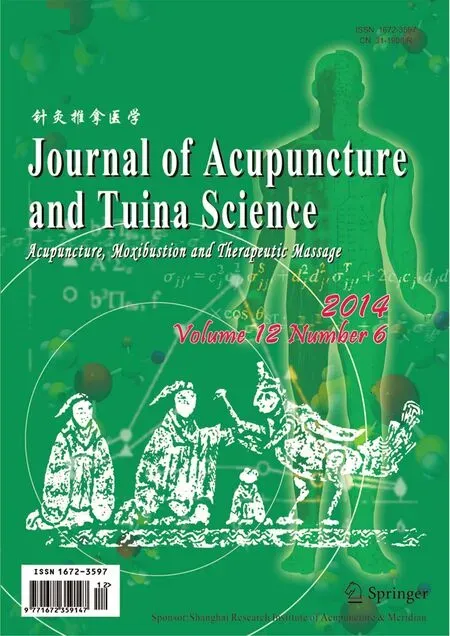Personal Experience on Palpation of the Spine
2014-06-27
The Fourth People's Hospital of Tongxiang, Jiaxing Second Hospital, Tongxiang Branch, Zhejiang 314502, China
TUINA TECHNIQUE AND EXERCISE
Personal Experience on Palpation of the Spine
Ling Jian-wei
The Fourth People's Hospital of Tongxiang, Jiaxing Second Hospital, Tongxiang Branch, Zhejiang 314502, China
Author:Ling Jian-wei, chief physician of Chinese medicine.
E-mail: ljw016@126.com
In addition to conventional palpation method, examination on vertebral range of motion (ROM) and mobility can help to determine a pathological displacement and thus provide solid basis for spinal tuina manipulation.
Tuina; Massage; Palpation; Spondyloarthrop; Dislocations; Myalgia; Chiropractic
Spine plays a key role in the skeleton of the entire body. Four limbs and skull are connected with the spine either directly or indirectly. Load or impact of any body parts can affect the spine[1]. Consequently, it’s essential for clinicians to perform physical examination of the spine. However, it is difficult to diagnose spinal facet joint dysfunction since there are no specific symptoms or radiological (image) changes[2].
Palpation of the spine aims to examine each vertebra and associated joints, muscles, ligaments by sensation felt with the fingers and the patient’s reaction.
Through sensation of the fingers, the examiner can tell whether there is vertebral displacement (spinal facet joint dysfunction). The patient’s reaction refers to tenderness (or comfort). In other words, in addition to symptoms, palpation and the patient’s reaction are essential in spinal palpation. It is therefore necessary to investigate their basic concepts and interaction.
Displacement means a deviated or dislocated position or altered direction of one or more vertebrae. Tenderness (or percussion pain) manifests injury (or inflammation). Although in most cases, displacement can cause injury, not all injuries are caused by displacement. As a result, tenderness does not mean displacement. There are four interactions between displacement and tenderness: tenderness with displacementrelated injury; tenderness without displacement-related injury; healed injury in a displaced vertebra but not related to the displacement; and injury in physiological displacement but not related to the displacement.
In summary, tenderness can merely indicate injury (or inflammation) but cannot necessarily indicate displacement. Displacement can be pathological or physiological. Consequently, pathological or physiological displacement cannot be differentiated from displacement and tenderness. A pathological displacement can only be diagnosed with tenderness and associated changes in range of motion (ROM) or mobility. Palpation on ROM and mobility is now introduced as follows.
1 Palpation for Spinal ROM
This refers to examine the ROM of each vertebra with fingers. This method aims to examine active ROM and passive ROM.
1.1 Palpation for active ROM
This refers to examine the ROM of the spine and each vertebra with fingers when the patient is asked to perform spinal flexion, extension, lateral bending and axial rotation.
For palpation of active ROM, the patient is advised to take a sitting position and the examiner shall control the motion speed and amplitude. Also, it is important to compare the active ROM of adjacent vertebrae.
I started to use this palpation method because it’s difficult for patients to locate their pain and tenderness cannot be found through static palpation. By placing the hand onto the affected area and asking the patients to move the spine, they can tell the location of painful vertebra. I also found this method can help to diagnose vertebral displacement through different ROM of each vertebra.
1.2 Palpation for passive ROM
This method is based on the same principle as palpation for active ROM. During examination for passive ROM, it’s important to ask the patient to relax and cooperate and let the examiner know when they feel pain or discomfort. Take cervical vertebrae for example, place fingers of the left hand on the spinous or transverse processes (move from top to bottom) and place the right hand on the patient’s head to move his/her cervical vertebrae, and then to estimate vertebral position and ROM by feeling of the left hand and resistance changes felt by the right hand as well as the patient’s reaction.
Extension and rotation can be used for examination of the thoracic and lumbar vertebrae.
For examination of the thoracic vertebrae, ask the patient to take a prone position, flex the elbow, and cross upper arms. During extension of the back, the examiner presses the spinous process of each vertebra with the right hand to feel different ROM of each vertebra (Figure 1).
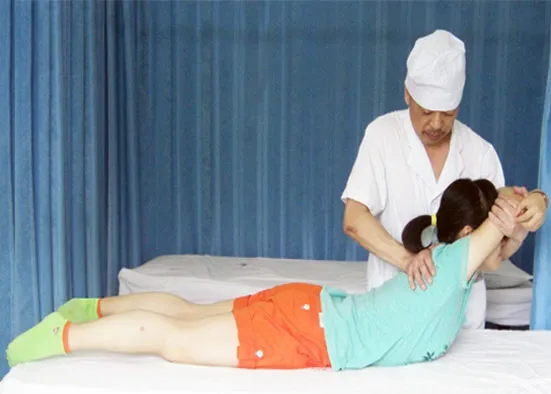
Figure 1. Examination of the thoracic vertebrae
For examination of the lumbar vertebrae, ask the patient to take a prone position. The examiner supports the legs with the right hand (an assistant may be necessary for overweight patients) to perform passive extension of the low back, and presses the lumbar vertebrae with the left hand to estimate different ROM of each vertebra (Figure 2).
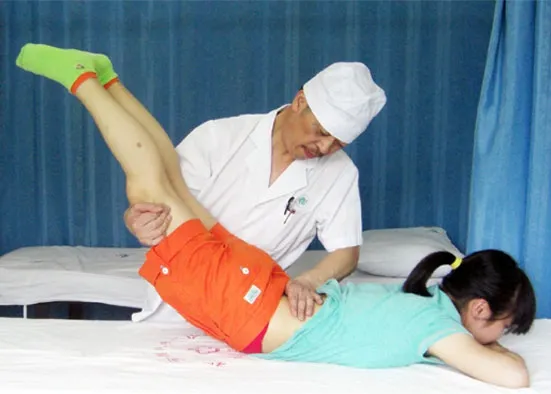
Figure 2. Examination of the lumbar vertebrae
For rotation examination, also ask the patient to take a prone position. The examiner presses the affected vertebrae with one hand and pulls the shoulder to turn the thoracic vertebrae with the other hand (Figure 3). Alternatively, the examiner can support the thigh to turn the lumbar vertebrae (Figure 4) and feel different ROM of each vertebra with the palpating hand. Then vertebral displacement or status of associated tissue can be evaluated by different ROM of each vertebra and the patient’s reaction.
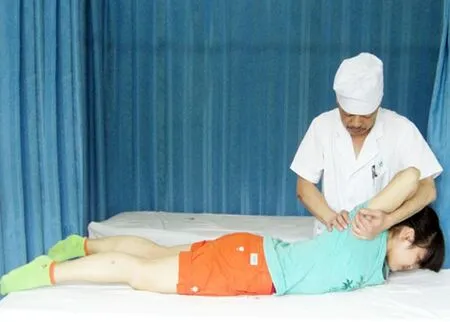
Figure 3. Thoracic rotation examination
2 Palpation for Spinal Mobility
2.1 Principle
This palpation is based on the principle that action of an external force (shear force) can result intranslational movement of any joints (i.e., lateral displacement, mobilization just like the Drawer test for the knee joint). Similarly, pressing a spinous or transverse process can cause an anterior-posterior (A-P) or left to right (L-R) movement or rotation of the vertebra. Vertebral displacement or joint problem can be evaluated by mobility of each vertebra.
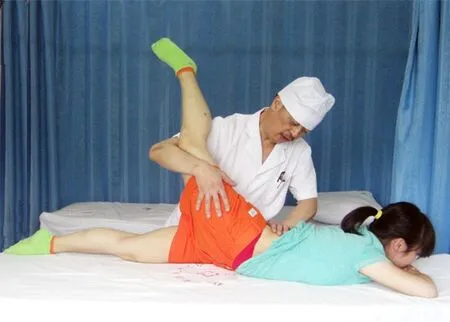
Figure 4. Lumbar rotation examination
2.2 Examination method of spinal mobility
Method 1: Press a spinous or transverse process with the middle finger of the right hand, place the left palm over the finger and press down to assess whether the vertebra is normal according to the mobility and patient’s reaction. During this process, it’s necessary to compare motilities of adjacent vertebrae (Figure 5).

Figure 5. Examination method 1 for lumbar mobility
Method 2: Place the middle and index fingers of the left hand to both sides of a spinous process, then place the thumb or palm of the right hand over the left middle or index fingers respectively to press towards the contralateral side and evaluate whether the vertebral mobility is normal. During this process, it’s necessary to compare both sides of adjacent vertebrae (Figure 6).

Figure 6. Examination method 2 for lumbar mobility
Palpation on mobility and spinal ROM can help to determine the location, direction and time of vertebral disorder as well as joint adhesion or damage to associated joints and soft tissue. It can also help to evaluate whether the adhesion is improved by traction or relaxation manipulation. What’s more, it can help us to decide whether adjustment is necessary or what manipulation we should choose.
3 Conclusion
Inappropriate posture and imbalance can increase certain muscle tone to remain stable. Otherwise, more force for inner equilibrium is needed. Since ligaments alone cannot secure the stability of the spine, subluxation of spinal joints may easily occur[3-5]. Physiological vertebral displacement can occur as a result of congenital defect (bifurcation of spinous processes), irregular morphology and direction of the spinous processes and asymmetry between left and right transverse processes, so it is important to identify a physiological displacement from a pathological one[6-8]. In addition to conventional visual diagnosis and three-finger palpation, examination on spinal ROM and mobility can help with a more reliable differentiation between a physiological displacement and a pathological one, and thus improve the efficiency of spinal palpation and the diagnosis of spine-related disorders. Furthermore, this can help us prevent two events: fruitless or even counterproductive spinal adjustment for patients with a physiological displacement; missed diagnosis of a pathological displacement[9].
In addition, this palpation method is helpful in determining the time of displacement: displacement is often recent if it’s associated with notable decrease in ROM and mobility as well as severe tenderness; displacement is often old if the tenderness is not severe. Displacement without abnormal changes inROM and mobility is mostly physiological, regardless of absence or presence of tenderness. Generally, adjustment is not necessary for a physiological displacement. Considering from the safety of manipulation, this palpation method can obtain optimal clinical efficacy with minimal stimulation and shortest tuina treatment time[10].
[1] Lu XM. Chiropractic lectures on common spine-related disorders. Zhongguo Xiangcun Yiyao, 2013, 20(13): 34-36.
[2] Zhu XL, Zhang ZC, Tao J, He YG, Zhang W, Wang Y, Zhao YT. Rotation-pulling manipulation for spinal facet joint disorder. Zhongyi Zhenggu, 2011, 23(5): 68-69.
[3] Li YK. Basic issues in Chinese spinal tuina. Jingyaotong Zazhi, 2004, 25(2): 129-131.
[4] Zhang QM, Fang M, Gong L. Considerations on spinal massage clinical teaching. Shanghai Zhongyiyao Zazhi, 2003, 37(9): 46-48.
[5] Shen GQ, Yan JT. Reflections on ‘subluxation’ and‘adjustment’ in spinal tuina. Shanghai Zhongyiyao Daxue Xuebao, 2002, 16 (2): 26-28.
[6] Yan YB, Lu XM. Biological effect of spinal tuina. Shaanxi Zhongyi, 2008, 29(7): 884-885.
[7] Chen TC, Chen Y, Wang SX. Clinical observation of acupuncture combined with massage manipulation on treating facet joints disorder. Sichuan Zhongyi, 2013, 31(9): 128-130.
[8] Liu AS. Effect of ZPT on PLID. Zhongguo Ziran Yixue Zazhi, 2001, 3(1): 21-23.
[9] Shao FY, Shao HL. Applied Examination of Pain in the Neck, Shoulder and Leg. Zhengzhou: Henan Science and Technology Press, 2002: 226.
[10] Shi NN, Shen GQ. Development and evaluation of Chinese spinal manipulation. Anmo Yu Kangfu Yixue, 2013, 4(8): 13-14.
Translator:Han Chou-ping
R244.1
: A
Date: July 15, 2014
杂志排行
Journal of Acupuncture and Tuina Science的其它文章
- Tuina plus Ultrasonic Therapy for Infantile Muscular Torticollis
- Efficacy Observation of Tuina Therapy for Fibromyalgia Syndrome
- Warm Needling Moxibustion at Zhongji (CV 3) and Zusanli (ST 36) for Urinary Retention after Gynecological Surgery
- Acupoint Massage in Relieving Pain after Ureteroscopic Holmium Laser Lithotripsy
- Therapeutic Efficacy Analysis of Balancing Yin-yang Manipulation for Post-stroke Upper Limb Spasticity
- Therapeutic Efficacy Observation on Acupoint Sticking for Edema Due to Chronic Cardiac Failure
